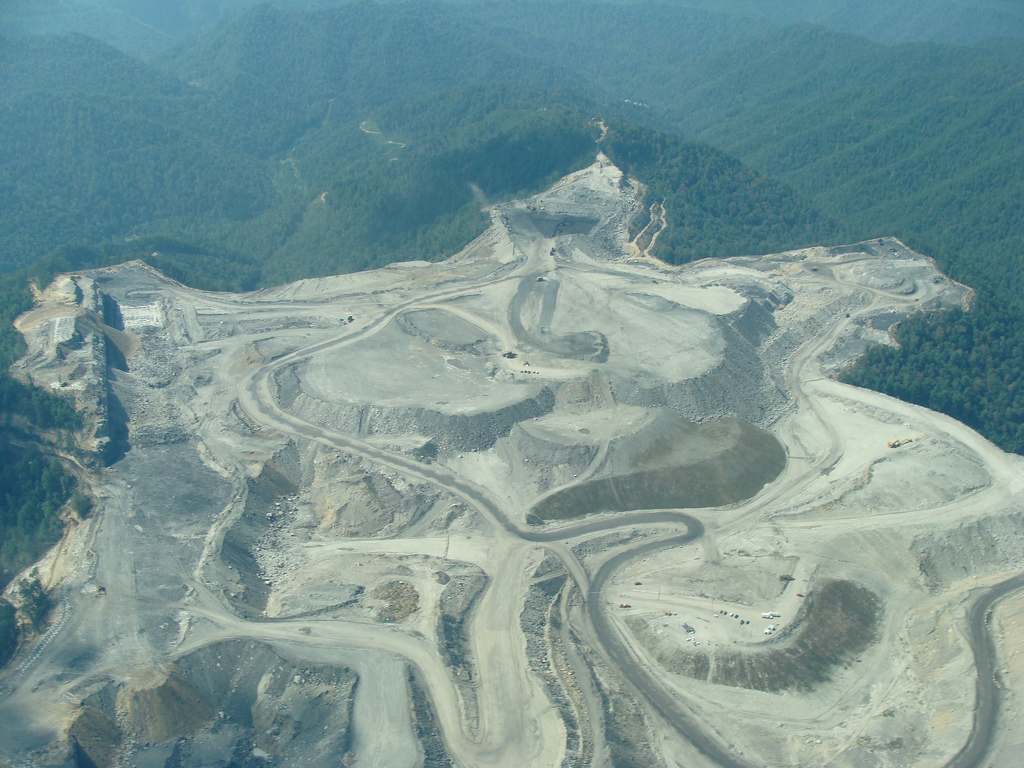Congress Takes on Mountaintop Mining
After decades of abetment, Congress is watching with more critical eyes.
Jul 31, 20204.7K Shares598.1K Views
A mountaintop mine in West Virginia (NRDC photo)
America’s oldest mountains are being decimated, and after decades of abetment, Congress is finally watching with more critical eyes.
In a Senate hearing on mountaintop mining last week, lawmakers called for an end to the popular and lucrative practice of topping the Appalachian Mountains to tap the coal inside.
Illustration by: Matt Mahurin
That process, in which mining companies blast away mountain peaks and push the debris into nearby streams, has been a boon to the industry, cutting labor costs and eliminating the need to truck the waste to more distant dumping grounds. But it’s also ravaged neighboring communities by poisoning waterways, contaminating air, killing off wildlife and flooding nearby homes.
In the name of job creation and energy economics, lawmakers for decades have permitted — even encouraged — the practice, despite its apparent conflict with federal laws designed to protect the nation’s water resources. But some in Congress are starting to take a closer look at the broader effects of the process — and they don’t like what they see.
“Mountaintop coal mining is a long-term assault on Appalachia’s environment, economy, culture and the health of its citizens,” Sen. Ben Cardin (D-Md.), chairman of the Senate Environmental and Public Works Subcommittee on Water and Wildlife, said Thursday. “We must put an end to this mining method that has buried more than a thousand miles of streams and created untold threats to some of the most beautiful and ecologically significant regions of our country.”
Although the Environmental Protection Agency has vowed to rein in the most destructive mountaintop projects, Cardin, along with Sen. Lamar Alexander (R-Tenn.), are hoping to eliminate the practice altogether. The two have introduced legislationto prohibit the dumping of mine debris into streams. A House bill, sponsored by Reps. Frank Pallone (D-N.J.) and Dave Reichert (R-Wash.), has 151 co-sponsors. The intention is to make mountaintop removal economically unattractive to companies that would be forced to truck the waste off-site. Cardin and Alexander are planning a second subcommittee hearing this summer to examine their proposal.
They have a tough road ahead.
Coal generates more than half the electricity in the United States, and countless industries have a vested financial interest in keeping it as cheap as possible. That message hasn’t been lost on Capitol Hill, where policymakers — both Democrats and Republicans, both in the Appalachians and outside — have defended mountaintop removal as being vital to fuel the nation’s energy needs and sustain much-needed jobs in an economically depressed corner of the country. The environmental devastation that results, the thinking goes, is just the necessary evil of meeting these more important economic goals.
“Banning coal or sharply curtailing its use makes no sense to people who rely on it every day of their lives,” said Sen. James Inhofe (Okla.), the senior Republican on the Environmental and Public Works Committee.
The issue has been a thorn in the side of the young Obama administration. On one hand, the White House wants to make good on campaign promises to eliminate mountaintop miningin favor of less destructive methods. On the other, it doesn’t want its tighter standards to spike fuel costs or unemployment, particularly in the middle of a recession when joblessness continues to rise.
As a result, the administration has struggled to find a balance between applying stricter environmental standards to mountaintop mines and being careful not to hobble a powerful economic engine in the process. Indeed, after vowing to reassert its powersto scrutinize pending mountaintop permits, the EPA last month authorized 42 — and rejected just six — new coal projectsin the Appalachian states. Most of those are surface mines— including mountaintop removal projects — that will fill scores of valleys and bury miles of tiny streams representing the headwaters of larger rivers below. At least one project will fill six valleys alone.
In announcing that decision, an EPA spokesperson said it was the agency’s “understanding” that the projects wouldn’t “permanently impact high value streams that flow year round.”
Those criteria, however, concern many scientists, who argue that streams flowing only periodically are no less important to the health of ecosystems than those that run perennially. Margaret Palmer, environmental scientist at the University of Maryland, told lawmakers Thursday that headwater streams — even if ephemeral — perform vital tasks like water purification and nutrient cycling, processes essential to the health of food webs downstream.
“Headwater streams,” Palmer said, “are exponentially more important than their size would suggest.”
Between 1992 and 2002, mountaintop removal operations buried more than 1,200 miles of Appalachian streams, according to government estimates. At that rate, at least another 840 miles of streams have likely been filled since that analysis was done. Depending on how you define a stream, the number could be double that.
The mining industry and its defenders argue that companies, working with regulators, have taken extraordinary steps to mitigate the environmental damage associated with burying stream valleys, including the construction of drains beneath the fill and sediment ponds further downstream.
Randy Huffman, secretary of the West Virginia Department of Environmental Protection, testified Thursday that state regulators have “gone above and beyond the EPA’s recommended water quality parameters.”
Recent EPA efforts to limit valley fills, Huffman warned, threaten not only mountaintop removal projects, but all surface mines — and the livelihoods that depend on them. The National Mining Association estimates that mountaintop mining directly employs 14,000 people in Appalachia. “The people that live in the steep, narrow terrain of southern West Virginia need the opportunities created by surface mining,” Huffman said.
But don’t tell that to Maria Gunnoe. The resident of Boone County, W.Va., whose home abuts a mountaintop removal site, told lawmakers Thursday of the noise- and air- pollution horrors associated with living near the operation. But the larger trouble, she said, relates to the flooding and water contamination created by the mine runoff.
“The blasting is one nightmare, but the water pollution is horrible,” said Gunnoe, whose grassroots opposition to mountaintop removal won her the 2009 Goldman Environmental Prize, awarded annually to just one person per continent. “Myself and my children have a right as U.S. citizens to clean water. And that right is being taken away from us in the state of West Virginia.”
On top of creating jobs, the coal industry argues that mountaintop mining also creates future economic opportunities. Some of the newly plowed plateaus, for example, have been developed with schools, prisons and Wal-Marts.
But environmentalists and community activists question the value of new infrastructure if the environmental degradation of the place makes it unlivable.
“If people cannot live in those areas,” Gunnoe said, “there’s no need for shopping malls.”
Some Appalachian states have taken it upon themselves to protect their waterways. Tennessee, for example, has state laws that explicitly prohibit the dumping of mining debris in adjacent streams.
“There is neither sufficient social nor economic justification for such unalterable environmental and ecological insults,” Paul Sloan, deputy commissioner of the Tennessee Department of Environment and Conservation, testified Thursday. “In Appalachia, mountaintop removal and water quality are incompatible.”
Looking forward, stakeholders on all sides of the debate are anxious to see what the EPA does next. Aside from the 48 projects the agency has already reviewed this year, more than 100 pending applications remain for Appalachian mines. Of those, roughly 90 are located in Kentucky, according to Teri Blanton, who represents Kentuckians for the Commonwealth, a social justice group. That the EPA approved 42 of the initial 48, Blanton said, has given many state residents pause.
“I hope they scrutinize those 90 a hell of a lot more than those 42.”

Camilo Wood
Reviewer
Camilo Wood has over two decades of experience as a writer and journalist, specializing in finance and economics. With a degree in Economics and a background in financial research and analysis, Camilo brings a wealth of knowledge and expertise to his writing.
Throughout his career, Camilo has contributed to numerous publications, covering a wide range of topics such as global economic trends, investment strategies, and market analysis. His articles are recognized for their insightful analysis and clear explanations, making complex financial concepts accessible to readers.
Camilo's experience includes working in roles related to financial reporting, analysis, and commentary, allowing him to provide readers with accurate and trustworthy information. His dedication to journalistic integrity and commitment to delivering high-quality content make him a trusted voice in the fields of finance and journalism.
Latest Articles
Popular Articles

